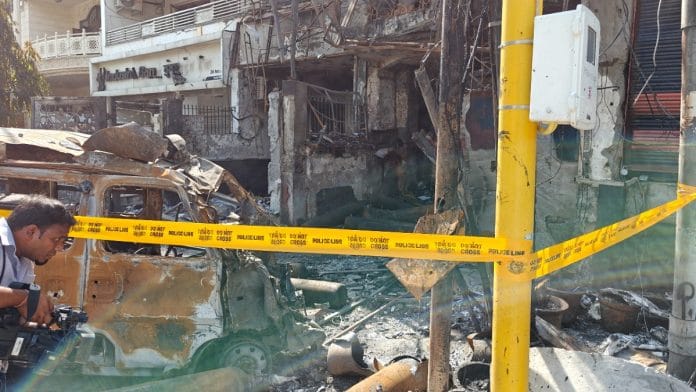Thank you dear subscribers, we are overwhelmed with your response.
Your Turn is a unique section from ThePrint featuring points of view from its subscribers. If you are a subscriber, have a point of view, please send it to us. If not, do subscribe here: https://theprint.in/subscribe/
India, often touted as the world’s next economic superpower, is grappling with a far more immediate and pressing issue: a pervasive and alarming lack of safety culture. Despite its aspirations to become a global leader, recent incidents across the country paint a grim picture of negligence, poor safety standards, and a glaring disregard for human life.
Recent Fire Incidents: Rajkot and Delhi
In the past few months, tragic fire incidents in Rajkot and Delhi have highlighted the dire state of safety measures. In Rajkot, a devastating fire in the gaming zone resulted in the loss of several lives. Investigations revealed that basic fire safety protocols were missing during welding operations, and emergency exits were either blocked or non-existent. Similarly, in Vivek Vihar, Delhi, a fire in a pediatric hospital led to the death of 6 newborn babies due to zilch safety protocols and inadequate firefighting equipment. Even providing NOCs is not reducing the problem, as it is not being checked regularly by either building owners or even by the govt authorities. NOC has just become a piece of worthless paper. These incidents underscore the urgent need for stringent fire safety regulations and their diligent enforcement.
Stampede in Hathras
The stampede in Hathras further exemplifies the lack of crowd control and safety measures in public gatherings. During a religious event, a sudden surge in the crowd led to chaos and a deadly stampede. The absence of proper planning, crowd management, and emergency response resulted in avoidable fatalities. Such incidents are not isolated; they are symptomatic of a larger issue where public safety is routinely compromised. Even after receiving permission from local authorities, why big shot IAS officers and their teams can’t review the safety measures, the way security of VIPs are being managed.
Road Accidents: A Daily Tragedy
India’s roads are among the deadliest in the world. The country witnesses thousands of road accidents every year, many of which are fatal. The reasons range from poor road infrastructure, reckless driving, lack of enforcement of traffic laws, and substandard vehicle quality. The exit of Ford from the Indian market was partly due to the low demand for safer, albeit more expensive, vehicles. Consumers often opt for cheaper cars, ignoring the critical aspect of safety, resulting in a market flooded with unsafe vehicles. Companies are least bothered on this aspect, as they all have focus on the annual sales numbers.
Compromised Structural Quality
Structural integrity in India is another area of grave concern. The collapse of a bridge in Bihar and the recent incident of a roof falling at Delhi Airport are stark reminders of compromised construction standards. These incidents are often attributed to corruption, use of substandard materials, and lack of regular maintenance. When cost-cutting takes precedence over safety, the results are disastrous. The recurring bridge collapses and infrastructure failures reflect a systemic issue that requires urgent attention.
Zero Focus on Maintenance
Maintenance is the backbone of any safety protocol, yet in India, it is grossly neglected. Whether it’s public infrastructure, vehicles, or even emergency equipment, maintenance is often an afterthought. The result is malfunctioning equipment, deteriorating infrastructure, and an increased risk of accidents. The country seems to be in a perpetual state of firefighting rather than adopting a proactive approach to maintenance and safety.
Distractions from Core Issues
Amidst these pressing safety concerns, national discourse is often hijacked by polarizing debates on Hindu-Muslim relations, Ramrajya, and historical figures like Nehru, Gandhi, and Savarkar. While these discussions have their place, they should not overshadow the critical need to address basic safety and infrastructure issues. The focus on becoming the third-largest economy is meaningless if the country cannot ensure the safety and well-being of its citizens.
The Need for Pragmatic Risk Assessment
Risk assessment is not just a financial tool; it is a vital component of safety systems. Implementing thorough risk assessments can identify potential hazards, evaluate their impact, and develop strategies to mitigate them. Unfortunately, this pragmatic approach to safety is often missing in India. There is a dire need for industries, government bodies, and communities to adopt a culture of safety that prioritizes risk assessment and proactive measures. There is a dire need of a specific” ministry of Safety” who can keep a check on all govts/ NGOs, private organizations and this methodology need to be commenced at School level itself, the way Japanese ensures in their schooling systems.
Conclusion
India’s safety culture is in a pathetic state, with glaring deficiencies in fire safety, crowd management, road safety, structural integrity, and maintenance. While the country aspires to be an economic powerhouse, these aspirations are hollow without a fundamental commitment to the safety and well-being of its people. It’s time for India to wake up to the harsh reality and take concrete steps to build a robust safety culture that protects and preserves lives. The journey towards becoming a global leader begins with ensuring that every citizen can live and work in a safe & secure environment and that should be commenced from basic school curriculums.
(This article has been written by Lt Cdr Harikesh Yadav (retd), Ex-Indian Navy)
These pieces are being published as they have been received – they have not been edited/fact-checked by ThePrint


